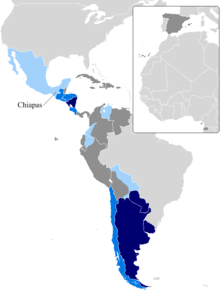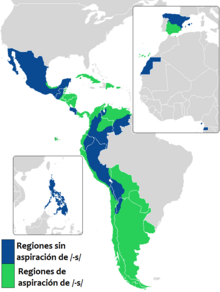User:Steffihelene/sandbox
Paraguayan Spanish[edit]
Paraguayan Spanish is a form of the Spanish language spoken in the Republic of Paraguay, which exerts a certain influence in the nearby regions of northeast Argentina. It is characterized by having strong influences of Guarani, since Paraguay is the only Spanish-American country with the majority of its population being bilingual.[1]
Paraguayan Spanish possesses marked characteristics of Spanish previously spoken in northern Spain, because the majority of the first settlers were old Castilian and Basques.
In addition to the strong influence of Guarani, Paraguayan Spanish is also influenced by River Plate Spanish due to the geographical, historical, and cultural proximity, as well as the sharing of features such as voseo, which is "the use of vos as a second-person singular pronoun."[2]
Characteristics[edit]

Main Characteristics[edit]

- Absence of yeísmo, the pronunciation of the digraph <ll> as a palatal lateral consonant [ʎ] is different from that of the <y> that is articulated most of the time as an affricate consonant [dʒ].1
- Voseo: pronominal and verbal, identical to River Plate Spanish.
- Leísmo: when one uses le in the context of a direct object pronoun instead of the personal pronouns lo and la.
- Contains less pauses and less "musical" intonation than River Plate Spanish.
- Inherited from Guaraní, slang= Guarani
Pronunciation[edit]
First of all, the heterogeneity of the following characteristics are not always applicable to all Paraguayan Spanish speakers, specifically the pronunciation of the letters "r" and "s," which differ according to the social environment.
- The grouping "tr" is pronounced as a voiceless postalveolar affricate [tɹ̥̝], similar to the sound of the digraph /ch/.
- Assimilation of the "r"= Assibilation
- Wide diffusion of the labiodental [v] for the phoneme /b/.
- The word-final /n/ has alveolar articulation, not velar.
- Non-aspirated realization of /x/.
- Hiatus (linguistics) conservation
- Stable vowel system.
- Weak articulation of /b/, /d/, and /g/ in intervocalic position (and even initial position).
- In some variations of Paraguayan Spanish the "rr" is not pronounced as an alveolar trill, as done by many of the Spanish-speaking regions, but as a [ɹ̝] similar to the English R or how the Sicilian R is done in Italy.
- Use of the alveolar approximant [ɹ] for the pre-consonantal and final "r," similar to the pronunciation in American or Dutch English. Example: firmar [fiɹ.maɹ]
Dynamics of Guarani-Spanish[edit]
Typical Paraguayan Spanish has a strong influence of the sentences of Guarani in its translation to Spanish, as well as the words and borrowed particles of Guarani for colloquial expressions. These are some common cases:
- Guarani particles among Castilian words to emphasize expressions. Examples:
- -na ("por favor"). E.g.: Vamos na = Vamos por favor
- -pa, -pió, -piko, -ta (interrogative particle without translation). E.g.: ¿Para qué pa?, ¿Para qué pió? = ¿Para qué?
- -ko, -nio, -ngo (particle to emphasize something). E.g.: Ese ko es de ella.
- Words taken from Guarani for use in everyday Spanish. Examples:
- -gua'u (falsehood). E.g.: De gua'u nomás era = Era solo una mentira.
- ¡Mbore! (exclamation, rejecting something). Synonymous with: ¡Ni loco!
- ¡Kore!, ¡Nderakore! (exclamation, colloquially used for something terrible). Synonymous with: ¡Oh No!
- Sentences taken from Guarani translated partially or erroneously translated for use in everyday Spanish. Examples:
- "Se fue en Itauguá" (from the Guarani "oho Itauguápe", since the 'pe' is used interchangeably as 'a' or 'en')
- "Voy a venir" (literally from the Guarani "aháta aju", used as a synonym of "voy y vuelvo")
- "Vení un poco" (calque of the word "ejúmina" in Guarani)
- "Demasiado mucho calor hace" (calque of the word "hetaiterei" in Guarani)
- "Te dije luego" (from the Guarani "ha'e voi ningo ndéve", in which the "luego" emphasizes the previous action)
- "Me voy a ir ahora después" (calque of the Guarani sentence "aháta aga upéi", in which the "ahora" emphasizes when the action will take place)
- "Habló por mi" (literally from the Guarani "oñe'ẽ cherehe", used as a synonym of "habló de mi")
- Paraguayisms, words and sentences in Spanish, but influenced by Guarani. Examples:
- "Me hallo" ("hallar" is used as a synonym for "alegrar" instead of indicating the location situation)
- "Anda por su cabeza (influenced by the Guarani "oiko iñakãre", which would be "hace lo que quiere, sin control, sin juicio")
- "Te voy a quitar una foto" ("quitar" is used as a synonym for "sacar" or "tomar" in the case of taking pictures)

Similarities with the River Plate dialect[edit]
Due to the geographical and cultural proximity, both dialects are often confused. This is due to the fact that on the border between Argentina and Paraguay, the respective dialects fuse, creating a northeastern Argentine variety very similar to Paraguayan Spanish in the provinces already mentioned[3]. Examples:
- common use of the expression «che».
- sporadic aspiration of /s/ in colloquial speech.
- educated voseo and similar in conjugation.
- shares part of the River Plate lexicon (e.g.: some words in lunfardo).
Voseo[edit]
Voseo is a peculiar characteristic of Paraguayan Spanish which is heavily influenced by the River Plate dialect (since historically in Paraguay Guarani was always spoken, and Spanish was relegated to the inhabitants of the capital or the most favored classes in the interior of the country). Another characteristic of voseo is how long it has been around for. "Voseo is the oldest form of Castilian Spanish"[4]. After the second half of the 20th century, the teaching of voseo depended on whether the teacher used vos or not. Adding to the strong Argentinian influence, either by the media or by the geographical and cultural proximity, voseo stayed as a distinctive characteristic of Paraguayan. Although it is rarely taught in schools today, voseo is beginning to regain some popularity in the form of an accepted regional dialect.[5]
Also see[edit]
External Links[edit]
- A comparative dictionary of Spanish in Paraguay with the rest of Latin America
- Another example of the alveolar approach in the video of the production of a Pulp commercial
 | This is a user sandbox of Steffihelene. You can use it for testing or practicing edits. This is not the sandbox where you should draft your assigned article for a dashboard.wikiedu.org course. To find the right sandbox for your assignment, visit your Dashboard course page and follow the Sandbox Draft link for your assigned article in the My Articles section. |
- ^ Gynan, Shaw (1998). "Attitudinal Dimensions of Guaraní-Spanish Bilingualism in Paraguay". Southwest Journal of Linguistics. 17–2: 35–59.
- ^ Gerardo, Kayser (2001). El dialecto rioplatense = The River Plate dialect. Buenos Aires: Editorial Dunken.
- ^ Barrenechea, Ana María. "Estudios lingüísticos y dialectológicos: Temas hispánicos". Hachette Universidad: 115–35.
- ^ "Voseo", Wikipedia, 2019-06-06, retrieved 2019-06-07
- ^ "Voseo", Wikipedia, 2019-05-29, retrieved 2019-06-03
